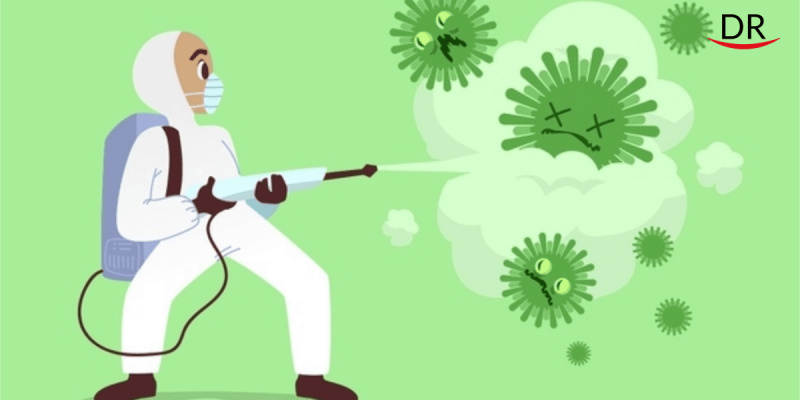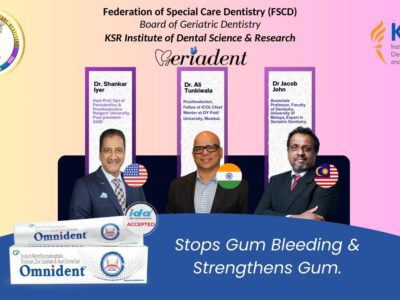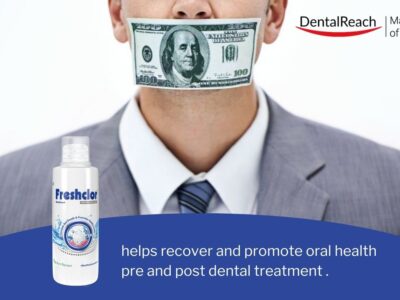Introduction
Disinfection is defined as a process that eliminates many or all pathogenic microorganisms, except bacterial spores, on inanimate objects. (CDC, Atlanta)
Disinfection is always done in at least a two-step procedure
- vigorous scrubbing of the surfaces to be disinfected and wiping them clean
- wetting the surface with a disinfectant and leaving it wet for the time prescribed by the manufacturer
In this COVID-19 era, we need to take extra care while disinfecting our clinic and instruments. Coronavirus Disease 2019 (COVID -19) is an acute respiratory disease caused by a novel Coronavirus (SARS-CoV-2), transmitted in most instances through respiratory droplets, direct contact with cases and also through contaminated surfaces/objects. The virus gets inactivated by chemical disinfectants.
Post-COVID dentistry is different from the pre-COVID era. Recently, a 3-article series was published, written by authors from the East, the West and the Centre – a truly global guidelines on Post-COVID dentistry which you can read here.
Ideal Disinfectant
The ideal disinfectant has the following properties:
- Broad spectrum activity
- Acts rapidly
- Non corrosive
- Environment friendly
- Free of volatile organic compounds
- Non-toxic
- Non-staining
Clinical Instruments Disinfection and Sterilisation
For this, categorise the patient care items in the clinic
1. Critical Items
Critical items penetrate soft tissue or bone and may contact the vascular or nervous system or any other normally sterile tissue, they have the greatest risk of transmitting infection. Critical items must be heat sterilised between use, or sterile single-use/disposable devices must be used.
Example: Surgical instruments, Periodontal scalers, Implant drills

2. Semi-critical Items
Semi-critical items contact mucous membranes or non-intact skin (eg – exposed skin that is chapped, abraded or has dermatitis), they have a lower risk of transmission. Semi-critical items should be heat sterilised or high-level disinfected.
Examples: mouth mirrors, amalgam condensers, wax carvers and reusable impression trays

Note: Any heat-sensitive item is processed using high-level disinfection.
Semi-critical Items Special Considerations
Dental Handpieces – Follow manufacturer’s instructions to safely reprocess dental handpieces and accessories (eg – low-speed motor, reusable prophylaxis angles). Clean and heat sterilise between patient uses. Do not subject the handpiece to high-level disinfection and do not wipe the surface with a low-level disinfectant.
Digital Sensors – Ideally, barrier protection should be used, followed by cleaning or high-level disinfection between patients.
3. Non-critical Items
Non-critical items contact intact skin of patients, they have the lowest risk of transmission. Non-critical items can be barrier protected with cling film or cleaned and disinfected (if visibly soiled) using a low to intermediate level disinfectant.
Examples: x-ray cone, facebows, BP cuff.

Factors Affecting Disinfection
- Organic and inorganic load present
- Type and level of microbial contamination
- Concentration of and exposure time to the germicide
- Physical nature of the object (eg – crevices, hinges, lumens)
- Presence of biofilms
- Temperature and pH of the process
- Relative humidity of the sterilization process (eg – ethylene oxide)
Types of Disinfectants
Thermal
All instrument washers and thermal disinfectants use either a detergent or a water-softening agent. It is possible for the pH of some of these chemicals to be incompatible with certain metals in dental instruments. For specific recommendations, the manufacturing instructions of the dental instruments and the instrument washer should be followed.
Chemical

- Detergent
- 70% Alcohol(ethyl, isopropyl, trichlorobutanol
- 1% Sodium hypochlorite
- Bleaching powder
How to Make Clinic Disinfectants
Refer to the pictures below to understand how to make solutions of disinfectants for clinic use




Equipment
Basic equipment checklist for a clinic

- Dust Mops / Sweeping tool (not broom)
- Mops
- Buckets
- Damp cloth / Sponge / Squeeze mop
Clinic Area Disinfection
It is better to divide your clinic into areas and disinfect accordingly. Learn more about altering your clinic design into areas by clicking here.
Surfaces
- Surface disinfection with 1% sodium hypochlorite (4 hourly) – High contact surfaces: Door-knobs, desks, chairs, stools, switches, etc
- No sweeping or dry mopping
- Three bucket technique for floor disinfection (4 hourly)
3 bucket technique
- Bucket 1 – plain water
- Bucket 2 – water with detergent
- Bucket 3 – 1% Sodium Hypochlorite

Ceiling and Walls
- Damp dusting with soap water and 1% sodium hypochlorite
- Once a week or after a suspect/ confirmed case
General Instruments
- Stethoscope: 70% alcohol/spirit swab before each patient
- BP Instrument and cuff: wipe with 70% alcohol/spirit swab before each patient, wash the cuff with detergent
- Injection and dressing trolley: clean daily with detergent and water, wipe with disinfectant after each use
Blood and Body Fluid Spill Care
- Cover with absorbent paper
- Cover the spill with 1% sodium hypochlorite for 10–20 minutes
- Clean-up spill and discard into infectious waste bin
- Mop area with soap and hot water
- Clean the mop and mop area with 1% sodium hypochlorite
- Wash mop with detergent and hot water

Refrigerators
Defrost, decontaminate and clean with detergent weekly
Reception Area
Floor disinfection: Three bucket technique (Twice daily)
Lockers, tables, cupboard, wardrobes, benches, shelves, cots, chairs and railings –
- Damp dust with warm water and detergent
- Surface cleaning with 1% sodium hypochlorite

Mirrors and glass, Stainless steel/ any other sink: warm water and detergent

Telephone: damp dust with warm water and detergent
Linen: Disinfect with 1% hypochlorite for 20 minutes and wash with detergent

Clinic Toilets
Toilet pot / commode & lid, taps, sink and soap dispenser: 1% Sodium hypochlorite, scrub and wash with soap water
Toilet floor: scrub and wash with detergent

Care of Mops
Detergent and 1% sodium hypochlorite
You can see the entire disinfection and PPE protocol in this video.
Conclusion
The COVID-19 pandemic is devastating but by following proper protocol for disinfection and sterilisation established by CDCP and National guidelines, we can definitely control the spread thus protecting ourselves, our hygienists, our patients and our family and make our country corona- free.
References
1. Coronavirus Disease 2019 (COVID-19): Prevention and Disinfection. IJBM: May-2020: Page No: 10-14
2. Sterilization Protocols in Dentistry – A Review . Lakshya Rani et al /J. Pharm. Sci. & Res. Vol. 8(6), 2016, 558-564.
3. Disinfection and Sterilization. Centre of Disease Control and Prevention.
4. National Guidelines For Infection Prevention And Control In Healthcare Facilities, MoHFW, Govt of India.
5. Van Doremalen N, Bushmaker T, Munster V J. Stability of Middle East respiratory syndrome coronavirus (MERS-cov) under different environmental conditions. European communicable disease bulletin. 2013 Sep 19; 18(38)
6. Otter J A, Donskey C, Yezli S, Douthwaite S, Goldenberg S D, Weber D J. Transmission of SARS and MERS coronaviruses and influenza virus in healthcare settings: The possible role of dry surface contamination. The JOHI. 2016 Mar; 92(3):235-50
7. Lai M Y, Cheng P K, Lim W W. Survival of severe acute respiratory syndrome coronavirus. Clinical infectious diseases: an official publication of the Infectious Diseases Society of America. 2005 Oct 1; 41(7):e67-71




















Comments